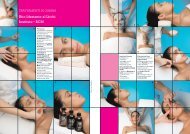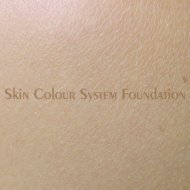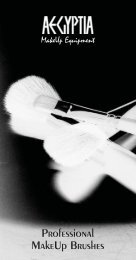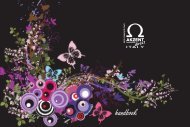Download handbook - BCM
Download handbook - BCM
Download handbook - BCM
Create successful ePaper yourself
Turn your PDF publications into a flip-book with our unique Google optimized e-Paper software.
ENGLISH<br />
VERSION
Skin Colour System Foundation<br />
is a product by<br />
The Product 1<br />
The Range 2<br />
The Light and the Colour 3<br />
The Optical Illusion 6<br />
The Light and the Dark 7<br />
The User’s Guide 10<br />
The Colour Chart 12
Skin Colour C<br />
System<br />
Foundation<br />
The Skin Colour System Foundation is the new range of compact foundations from<br />
Aegyptia. Innovative texture, easy to apply, great coverage and natural looking make up<br />
results are the most outstanding characteristics of this new compact foundations.<br />
The revolutionary formula combines excellent coverage, easy and smooth application for<br />
a perfect dosage of the product. It can be applied with “stretching“ movements for a<br />
natural, even and smudge-resistant make up base, or by tapping for more coverage and yet<br />
avoiding the “mask” effect.<br />
High in pigments content, the product grants an even colour and more intensive than usual<br />
to modulate coverage on need: it can be applied both locally as a concealer and on the<br />
overall as a make up foundation for a smooth natural-look.<br />
The combination of fine micropowders makes the application easier: the product, designed for<br />
professional use, becames easy to apply even for the less experienced users. The filming and<br />
protecting agents provide long lasting make up results an waterproof properties. Rich in Vitamin<br />
E, it perfectly hydrates and protects the skin from the aggressive action of free radicals.<br />
The product complies with the most severe international normatives (CEE - US - JP).<br />
1
The line includes 24 colours: all with the same texture, all extremely versatile. Skin Colour<br />
System Foundation represents a full range of foundations, concealers, neutralizers,<br />
highlights and shadows.<br />
2<br />
Foundation<br />
A foundation has a double purpose: to even out and smooth complexion, according to the<br />
natural skin colour and the chromatic dominance and to smooth out every imperfection in<br />
case of a real need (as per strong olive complexions or redness).<br />
Neutralizer<br />
A neutralizer is required to conceal and minimize skin imperfections or dyschromias<br />
(undereye circles, veins, couperose, birthmarks, etc.). The application follows the principle<br />
of complementary colours that they neutralize each others when superimposed. The aim<br />
is not to cover but to neutralize the colour of blemishes.<br />
Highlights and Shadows<br />
Volumes and face contours can be redefined by highlights and shadows through optical<br />
illusion effects. According to natural skin colour base, use lighter shades for highlights and<br />
darker shades for shadows.<br />
A brief introduction to the basic Colour Theory and to the concept of Optical Illusion<br />
is necessary for a proper and clever use of the Skin Colour System Foundations<br />
in corrective make up. Here a short information guide to achieve a perfect make up base<br />
and to conceal imperfections in the most appropriate way. The aim of the make up is to<br />
provide the complexion with an even and glowing look and refined face contours. This<br />
first step is essential to emphasize the make up of eyes and lips.
The Light and d the Colour<br />
Colour is a property of light, not an object in itself: to see colors, light must be present. The<br />
colour, as we perceive it, “is the visual effect that is caused by the spectral composition of<br />
the light emitted, transmitted or reflected by objects". If we direct a white light (the sun)<br />
onto a faceted surface (a prism or a diamond) this will separate white light into its<br />
component (rainbow) parts, which are the visible colours: magenta, orange, yellow, green,<br />
blue, indigo and violet. Objects have no colour of their own, but merely the ability to<br />
reflect a certain section of the visible spectrum. Objects reflect what we perceive and<br />
absorb what we don't see. The reflected light selected by our sensorial system (eye/brain)<br />
determines the colour.<br />
Therefore, the surface of a red object absorbs all the colored light rays, except for those<br />
corresponding to red and reflects this color to the human eye.<br />
The White and the Black<br />
White and Black do not exist in Nature. White is presence of light, black is absence of<br />
light. Therefore, an object reflecting all the light rays is white; on the contrary, when<br />
absorbing all light rays it results in black.<br />
3
Red Magenta, Yellow and Blue are regarded as primary colours; it means that they can not<br />
be mixed or formed by any combination of other colors. Between the three primaries are<br />
the secondary colours which are each a mixture of two of the primaries:<br />
RED<br />
+ YELLOW = ORANGE<br />
RED<br />
+ BLUE<br />
= VIOLET<br />
BLUE + YELLOW = GREEN<br />
All the intermediate colours can be obtained by varying the ratio of mixed colours.<br />
For instance, the secondary colour obtained by mixing yellow and blue is green: to<br />
achieve a green pea colour it is needed to add more yellow and more blue for a green sea<br />
colour. The cromatic wheel chart herebelow clarifies the connection between colours:<br />
YELLOW vs VIOLET<br />
ORANGE vs BLUE<br />
GREEN vs RED<br />
Any two colors which are directly opposite each other are called complementary colors:<br />
these opposing colors create maximum contrast. When superimposed they neutralize each<br />
other. These two basic properties of colours are strictly connected with the make up theory.<br />
4
Warm Colours and Cool Colours<br />
Colours can be classified as warm or cool. Reds and Yellows and their intermediates are<br />
conventionally referred to as Warm Colours. Greens and Blues and the admixtures of them<br />
are regarded as Cool Colours. Violet, resulting from the combination of a warm colour<br />
(red) with a cool one (blue), can be considered warm or cool depending on the prevalence<br />
of the red or of the blue colour.<br />
How to Conceal Dyschromias<br />
A correct know-how of the Basic Color Theory is essential for facing most common<br />
unwanted problems of skin imperfections, for choosing the most suitable colour<br />
foundation and smoothing out complexion in the most appropriate way. As explained,<br />
opposing colours neutralize each others. Therefore, to conceal ruddy tones (couperose,<br />
spots, etc.) it is advisable to use a foundation with a green chromatic dominance.<br />
According to the same principle, it is recommended to use orange-grade colours to<br />
neutralize blue tones (veins, halo beard, dark circles) and yellow-grade foundations on<br />
violet tones (shadows under the eyes, bruises, angiomas).<br />
The product should be applied with a sponge to work wide areas and with a brush on<br />
small areas. The product must be dosed according to the intensity of the dyschromia.<br />
5
The Optical Illusion<br />
Optical Illusion is a default in the principle of evaluation of reality operated by our<br />
sensorial system (eye/brain). Make Up is based on this theory and only following this<br />
principle we can modify partially or totally volumes and contours of a face.<br />
Optical Illusion can be widely employed in a corrective Make Up.<br />
Consider a subject overweight: in a black dress this will look slimmer. The same with a<br />
vertical striped dress: our eye will perceive it slender.<br />
Using the same logic, a shadow on a face volume will flatit down and a blush or an eye<br />
liner applied vertically on the face will emphasize the lenght of it.<br />
Shown herebelow are some examples of Optical Illusion:<br />
FIG 1<br />
Apparently A looks bigger than B; actually they are exactly the<br />
same size. To our sensorial system, dimensions are related to<br />
the entire scenary the entity is surrounded by more than to the<br />
single entity. According to this principle of evaluation, A<br />
surrounded by small circles looks bigger than B which is still<br />
surrounded by circles but with a larger diameter. The same<br />
principle is valid for the morphology of a face; a standard nose<br />
will look smaller on a wide face and bigger on a tiny one.<br />
FIG 1<br />
A<br />
B<br />
FIG 2<br />
FIG 2<br />
An other example of Optical Illusion.<br />
C e D have the same dimensions; however, if we consider the<br />
overall, the lenght of the two segments looks different.<br />
C<br />
D<br />
6
The Light and d the Dark<br />
Following the principle of Optical Illusion, dark tones make shapes to look flatter, shorter<br />
and smaller as they absorb the light. Besides, lenght, widness and protuberances can be<br />
emphasized by bright tones as they reflect the light.<br />
It is important to understand that what it can really modify a volume or a distance it is the<br />
absorbing or reflecting power of a colour (light and dark) and not the colour by itself.<br />
Many and various are the Light and Dark applications in make up.<br />
For instance, to enlarge a short forehead it is advised to use a shade lighter than the<br />
foundation; the product should be applied with stretching movements from the hair line<br />
downwards. To shorten a long chin it is better to use a shade darker than the base<br />
foundation; for the application, start from the chin tip upwards. Following the same<br />
principle it is possible to reduce a large forehead, to shorten a long nose or to soften a<br />
protruding jaw.<br />
For a more effective result, each intense area of highlight should be next to an intense area<br />
of darker shading.<br />
For instance, if you need more emphasis on the cheek-bone area, try to use highlights over<br />
the muscle structures and shade under and around the muscle.<br />
7
The following pictures show how to apply the dark and the light to achieve different<br />
effects.<br />
DARK<br />
LIGHT<br />
DARK<br />
DARK<br />
LIGHT<br />
DARK<br />
In this picture the chin and the forehead have been shortened as well as the nose. The zigomatic areas and the<br />
edges of the lower jaw have been emphasized by highlights.<br />
8
LIGHT<br />
DARK<br />
DARK<br />
LIGHT<br />
DARK<br />
LIGHT<br />
In this other pricture 2, the chin, the forehead and the nose have been extended while the cheek-bones and the<br />
lower jow have been softened.<br />
9
The User’s Guide<br />
11
The Colour Chart<br />
01<br />
02 03 04 05 06<br />
07 08 09 10 11<br />
12<br />
13 14 15<br />
16 17<br />
18<br />
19 20<br />
21<br />
22<br />
23<br />
24<br />
12
<strong>BCM</strong> Editrice<br />
Professional<br />
MakeUp<br />
Professional<br />
Phytocosmetics<br />
AirBrush<br />
MakeUp<br />
Professional<br />
Nail Styling<br />
Professional<br />
Handbooks<br />
Only for the Italian Market
Professional MakeUp<br />
a trademark of <strong>BCM</strong> Cosmetics • Piazzale Aquileia, 6 • 20144 Milano • Tel. +39 02 4982142<br />
www.bcm.it • cosmetics@bcm.it






